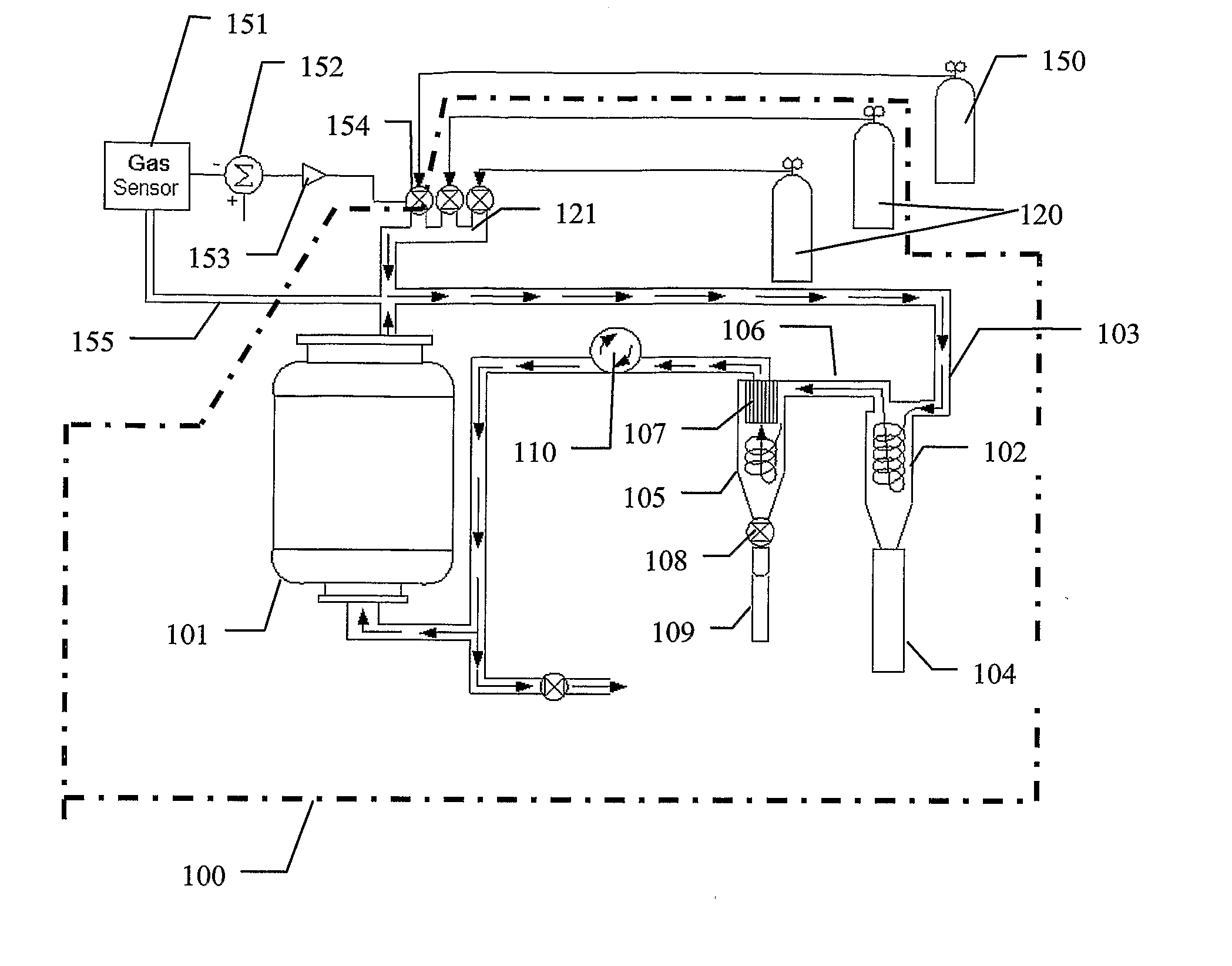Carbon and Metal Nanomaterial Composition and Synthesis
a technology of carbon and metal nanomaterials and composition, which is applied in the direction of powder delivery, pharmaceutical delivery mechanism, manufacturing tools, etc., can solve the problems of high surface energy of metal particles at this size, limited commercial availability of nanopowders, and unstable metal particles. , to achieve the effect of wide control range and high level
- Summary
- Abstract
- Description
- Claims
- Application Information
AI Technical Summary
Benefits of technology
Problems solved by technology
Method used
Image
Examples
example 1
[0057] The following tests were performed using the system invention of the present Application. The radial gun synthesis technique as described above was used to produce the material. A commercial dead-band feedback controller, Omega CNI 3222-C24, and hydrocarbon sensor, VIG industries FID Model 20, were integrated into the gas control system. Acetylene and methane were used for the hydrocarbon gas. All size measurements are computed based on BET measurements and an equivalent sphere diameter model.
[0058] The tests were conducted using the feedback controller to maintain specific levels of hydrocarbon including 0 ppm, 44 ppm, 440 ppm, 4400 ppm and 44,000 ppm in an atmosphere otherwise composed of helium and nitrogen at a total pressure of 1 atmosphere. All the tests were performed with the same production conditions with only the hydrocarbon and make-up gas concentrations being varied. Results are shown in Table 1.
TABLE 1Gas ConcentrationHydrocarbon(ppm)GasBET (nm)Agglomeration0...
example 2
Copper / Carbon Composite Using Acetylene
[0072] The same production conditions were used to make a copper and carbon composite material. At an acetylene gas concentration of 44,000 ppm, a material with a specific surface area of 44 m2 / g and 20 wt % copper and 80 wt % carbon was produced as shown in FIGS. 24A-D. The EELS K-edge spectra is shown in FIG. 25. The high □* peak, 2505, relative to the □* peak, 2501, indicates the material contains a high presence of sp3 carbon (diamond like carbon or fullerene) structures. The □* peak, 2501, also indicates that there is some sp2 carbon or graphitic carbon.
[0073] When nanocopper is produced in an inert atmosphere, it will readily oxidize and turn from black to a brownish green when exposed to even small amounts of oxygen. This has been confirmed by XRD analysis. The current nanocopper does not exhibit this feature and XRD analysis confirms that the copper remains copper when exposed to air.
example 3
Iron / Carbon Composite Using Acetylene
[0074] The same production conditions were used to make an iron and carbon composite material. At an acetylene gas concentration of 4,400 ppm, a material with a specific surface area of 65 m2 / g was produced as shown in FIGS. 26A-B. TEM images show graphitic structures, 2601, as well as other carbon structures. The EELS K-edge spectra is shown in FIG. 27. The relative heights of □* peak, 2701 and the □* peak, 2705, indicate the particles are interspersed in an sp2-bonded or graphitic carbon matrix. This material is attracted to a magnet and appears to be paramagnetic.
PUM
| Property | Measurement | Unit |
|---|---|---|
| Fraction | aaaaa | aaaaa |
| Fraction | aaaaa | aaaaa |
| Fraction | aaaaa | aaaaa |
Abstract
Description
Claims
Application Information
 Login to View More
Login to View More - R&D
- Intellectual Property
- Life Sciences
- Materials
- Tech Scout
- Unparalleled Data Quality
- Higher Quality Content
- 60% Fewer Hallucinations
Browse by: Latest US Patents, China's latest patents, Technical Efficacy Thesaurus, Application Domain, Technology Topic, Popular Technical Reports.
© 2025 PatSnap. All rights reserved.Legal|Privacy policy|Modern Slavery Act Transparency Statement|Sitemap|About US| Contact US: help@patsnap.com



